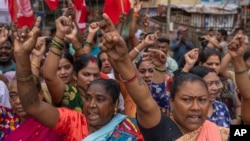In a narrow alley in Dharavi slum in Mumbai, sewing machines hum as workers in Abdul Kadir Ansari’s small tailoring workshop turn out garments for women. Ansari aspires to develop his four-year-old shop into a bigger business.
But an ambitious $3 billion plan to redevelop one of the world’s largest slums worries him. “My workshop here will have to close when buildings come up. I don’t know if I will be given a place to run my business,” said Ansari.
The government, which has been planning to overhaul Dharavi for decades, has awarded a contract to the Adani Group to pull down the rickety shanties that sprawl over 250 hectares in the heart of Mumbai and develop modern buildings. The slum that featured in the movie Slumdog Millionaire is home to a million people, many of them migrants who over decades came to India’s financial capital to make a living in the city.
After resettling eligible residents, commercial and residential complexes are expected to be developed on the prime real estate that would be freed up in a city starved of space.
There is optimism about exchanging their dismal living conditions for flats in modern buildings. Open drains, shared toilets, and paucity of water are daily challenges that residents like Pramod Khade cope with.
My father, my grandfather, and my great grandfather all stayed here. At least our generation should live in a building. That is what many of us dream about,” said Khade as he glanced at the tall buildings in the neigborhood that tower over the slum.
Gautam Adani, founder and chairman of Adani Group, wrote in a blog post on the company's website in July that the redevelopment will create a modern city hub and provide gas, water, drainage, healthcare and other facilities to residents.
However, there are fears among Dharavi residents that the slum’s makeover could cost them their livelihoods. Over decades hundreds of workshops have sprung up in its tangle of lanes. Some recycle plastic waste; others produce goods such as leather bags and garments. In courtyards, women craft pottery or roll out a crunchy Indian snack called ‘papad.’ These informal businesses have transformed Dharavi into an industrial hub that produces products worth an estimated one billion dollars.
“The entire ecosphere and business fabric of diverse and distinct trades thriving in Dharavi will be rehabilitated and rehoused,” Adani said on his website.
But the thought of displacement worries many like Jaya Behan whose family runs a pottery business. While she would be eligible to get a house, she points out that women who bake and paint clay pots in courtyards need unhindered access to kilns and open spaces, which buildings cannot provide.
She does not know how her family will manage if their pottery business has to shut down. “We cannot get jobs. Nobody will employ me at this age,” said 68-year-old Behan sitting in her shop on Dharavi’s main street. “We people are not educated and only the educated get jobs.”
Entrepreneur Megha Gupta, who works with leather craftsmen in Dharavi says the enterprise in the slum is immense, but earnings are meager. “People over here work to survive. They are not really thriving. It is because they work on very low margins,” said Gupta. Her online platform, Dharavimarket.com helps them access more customers.
Earlier this month, she handed certificates to those who had attended courses aimed at improving their skills. Among them is Satyawan Maruti Kamble, who learnt the craft of making leather products from his father. A rickety iron staircase leads to his work space above a shop selling goods such as handbags, wallets and laptop bags.
“There is a workshop on top of every house here. So the development should ensure that we have homes as well as places to work,” said Kamble.
Gupta is confident that Dharavi’s redevelopment will involve rehabilitating the small businesses.
“You cannot take one million people out of their place and tell them OK, just work somewhere else,” points out Gupta. “They are considering it, but it is going to be a difficult project. Nowhere in the world something like this has happened, whether in terms of the quantity of houses to be delivered, or workspaces to be delivered or the number of people to be rehabilitated."
There is also apprehension among some residents about the project being handed to the Adani Group, which was accused of stock price manipulation and accounting fraud earlier this year by U.S. -based short seller Hindenburg Research. The group, which is involved in everything from ports to energy, has strongly denied allegations of corporate malpractice.
“Many in Dharavi don’t have trust in Adani because of the allegations made against it,” according to Khade. “People here too follow the news and they worry about the project getting stalled after their houses are pulled down. Then where will we all go?”
Residents say they have not been consulted so far about the proposed revamp, which would take several years. But their position is clear -- they want to remain close to the city center.
“Dharavi is a very central place for my work. My main market is here and my rent is low,” said tailoring workshop owner Ansari. “I am tense because my costs will increase if I have to move.”
Those tensions will persist for many until they know how plans to transform Dharavi into a modern hub will impact their lives.











